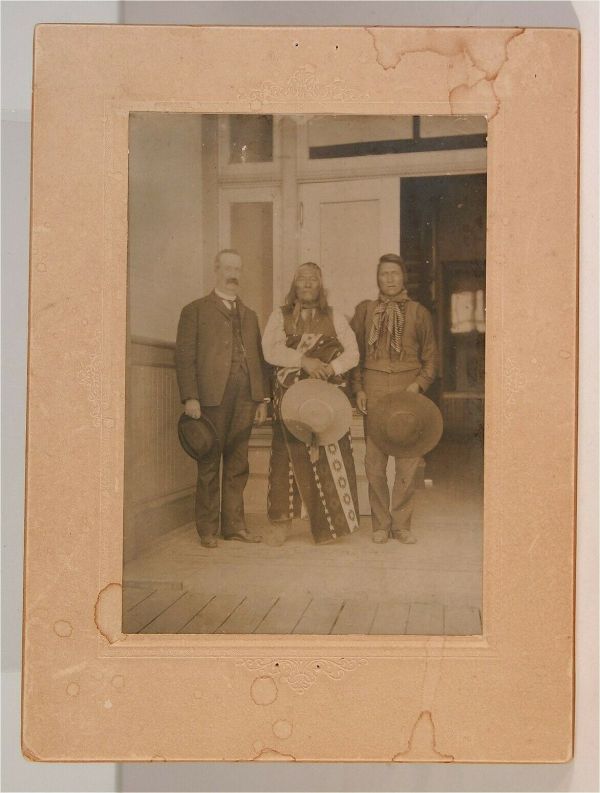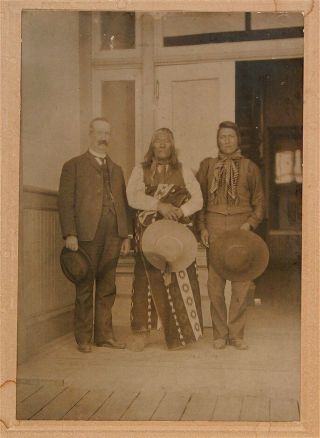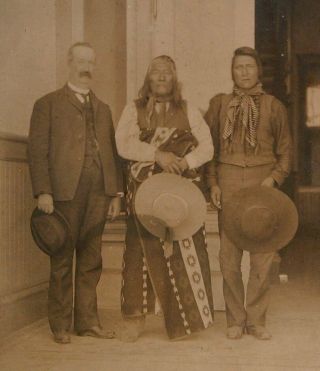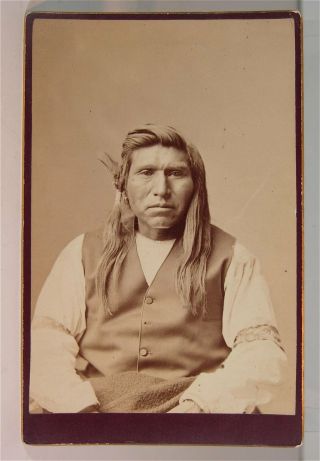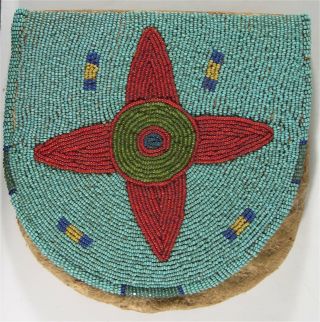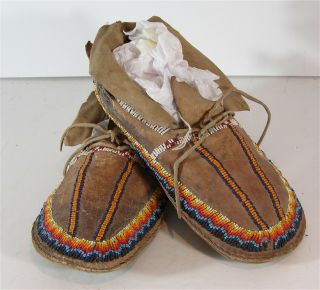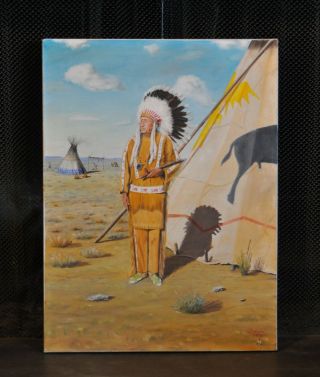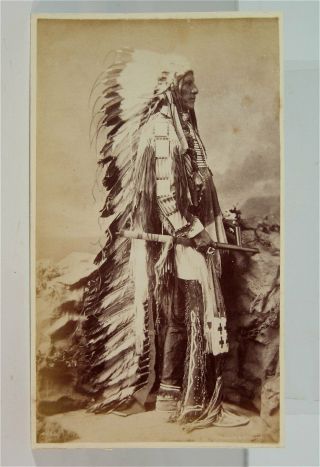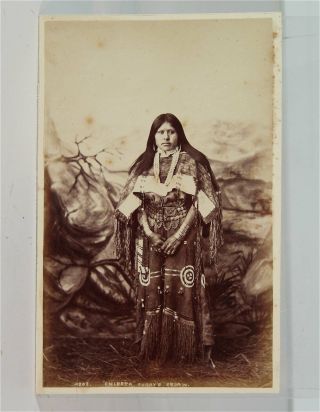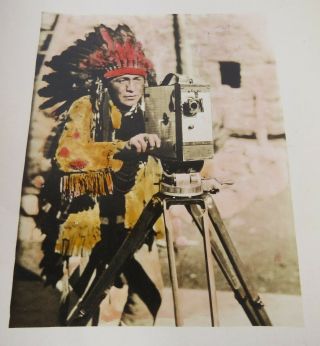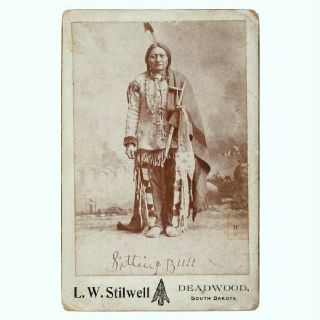Ca1906 NATIVE AMERICAN SHOSHONE INDIAN CHIEF TENDOY & AGENT CABINET CARD PHOTO
Item History & Price
| Reference Number: Avaluer:53032918 | Original/Reprint: Original Print |
| Culture: Native American: US | Original/Reproduction: Original |
| Tribal Affiliation: Shoshone |
Very rare and original, ca1906 Cabinet Card Photograph of the Great Native American Lemhi River Valley Shoshone Chief Tendoy with his son (also named Tendoy) and Fort Lemhi (Idaho) Indian Agent M. McPherson.
This outstanding Photograph of Shoshone Chief Tendoy was likely taken ca1906 when 468 members of of Tendoy’s Lemhi Shoshone Band agreed to move to Fort Hall in southeastern Idaho – Tendoy did not move to Fort Hall with his band and died a year later i...n his home on the Lemhi River.
This wonderful, Cabinet Card Photograph pictures Shoshone Chief Tendoy wearing a combination of traditional and western garb and holding a very wide brimmed hat. To his left is his son Tendoy dressed in western garb and holding a similar wide brimmed hat. To Chief Tendoy’s right stands Lemhi River Agency Indian Agent M. McPherson.
This original, Card Mount Photograph measures approx. 3 7/8" by 5 5/8" and is mounted on its original, photographer's card mount (overall size of card mount is approx. 6" by 8"). There is a manuscript label affixed to the back of the mount that identifies the subjects however the Cabinet card does not carry the mark of the photographer.
The Lemhi River Valley was the site of the Fort Lemhi Mission established by Mormon missionaries in 1855. They taught the Shoshone Indians who lived in the Valley how to plant hay and grain and instigated an irrigation system to water the crops. It was abandoned in 1858 when trouble interrupted between various tribes with the white man in the middle. The troublemakers left with the tribe’s cattle and horses.
Around this time Chief Tendoy united his small band of Shoshone, Sheepeaters, and some Bannocks. He'd been their Chief since he was a young man in 1862 and kept his band from going to war with the whites. He prevented them from pillaging and trespassing on others’ property. In 1859, C. H. Miller, from the Bureau of Indian Affairs, presented him with a fine rifle as a token of "Government appreciation for his service and friendship to the Americans."
At Wood River, a renegade band of Bannocks, under Pagwhite, attacked three white men, killing one and wounding another. Their seven horses were stolen. Two days later the same band captured a mule train of 47 animals. Chief Tendoy and his band of Lemhi Indians were camped seven miles away trading with the Nez Perce when they heard of the attacks. Tendoy went in search of the wounded white man and his companion. Finding and caring for them the Lemhi Indians rode to the Bannock camp and demanded the return of the stolen animals. This caused an uproar but Chief Tendoy's Lemhis took the animals that had been stolen and returned them to their owners. The Chief was invited to Boise where the Governor of Idaho Territory presented him with a flag and some supplies "for his faithfulness to the cause of peace." The guilty Indians were brought to justice and jailed.
Indian Agent A. J. Simmons proposed that a reservation be established for the Lemhi Indians in their valley. It would be only one hundred square miles in size on the Lemhi River. The Indians expressed a desire to farm, so an appropriation of $5, 000 was given to them for seeds and machinery. The tract of land was assigned to the Tendoy Indians by the Treaty of 1868 but was never ratified.
In 1872 an additional $25, 000 gift was given to the Indians with a recommendation that they all move to Fort Hall. Chief Tendoy would be made Chief of all the Bannocks and Shoshoni in Eastern Idaho Territory.
A Presidential Order of February 12, 1875 finally established the Lemhi Valley Indian Reservation. It soon became a crossroads for the Nez Perce, Flathead, Shoshoni and Bannocks on their annual trek to the buffalo country. This drained a supplies of this small reservation and many Lemhi were going hungry. Because of the scarcity of rations, some Bannocks moved to Fort Hall. Food rations were scarce there as the agent had cut them in half. By April 20, 1876 all supplies had been exhausted. The tribes were hungry and were forced off the reservation to continue their nomadic wanderings in search of food. The government seemed indifferent to their need to survive. This led to the start of the so-called Bannock War of 1878.
Throughout the conflicts the Lemhi Indians remained peaceful and friendly to the whites. Chief Tendoy prevented tribal members from joining in on the warring expeditions of the Bannocks. Indian agents still did not provide enough provisions to support Tendoy's band of six or seven hundred so they moved to the Yellowstone region in search of food.
The U.S. Commissioner of Indian Affairs called the four Indian leaders in the southern Idaho area to a conference in Washington. Finally, all the chiefs agreed, in 1880, to move their tribes to the Fort Hall Indian Reservation. The agreement stated that the Lemhi’s would receive $4, 000 a year for 20 years in compensation for their loss. The Bannocks and Shoshonis would receive $6, 000 a year for 20 years. Reservation land was allotted out - 160 acres of farming and 160 acres of grazing land to each person over 18. Children were allotted half of that. White settlers had taken possession of reservation land south of the Portneuf River, and they wanted titles to their land. It was decided to sell off the southern end which reduced the reservation size by 450, 000 acres.
Chief Tendoy, along with tribal members, visited Fort Hall in 1888 and agreed to move, providing Congress ratified the Treaty of 1888. Congress finally ratified this agreement in 1889. The Lemhi’s were still reluctant to move. In 1906, 468 members of the Lemhi Indians left their homes on the Lemhi and moved to Fort Hall. Their land allotment was 80 acres of farming land and 80 acres of grazing land. The U.S. government granted Chief Tendoy a pension of $15 a month for the remaining 15 years of his life. He stayed behind in his house on the Lemhi River where he died on May 9, 1907. A large monument marks his grave in the Lemhi River Valley.
This very rare and wonderful, Native American Shoshone Indian Cabinet Card Photograph is in very good condition. The Photograph exhibits sharp focus but is somewhat light overall. The Image itself is generally clean and crisp and well preserved while the card mount has some water staining, soiling and light edge wear.
A very rare and wonderful, ca1906 Native American Indian Cabinet Card Photograph of the legendary Shoshone Chief Tendoy and his son and a fantastic addition to any collection!!!
Be sure to check out this seller’s other auctions for a number of other 19th and early 20th century Native American Indian Photographs and Artifacts which are also being offered for sale this week on eBay!Overseas shipping is extra and cost will be quoted at bidders request. Massachusetts residents must add 6.25% sales tax. Please check out other early and interesting items offered by this seller on ebay. Click Here to See Our Items We Have for Sale in the eBay Gallery and Click Here to Add Us To Your Favorite Sellers List.
Important Notes about Shipping Charges: The amount quoted for Shipping & Handling is calculated by eBay and is equal to the EXACT amount charged by the Post Office plus a $1.00 "packing fee" - the $1.00 fee is our only compensation for the virgin packing materials we use on all of our professionally packaged boxes as well as our cost for the salaried help that does most of our packing - as I am sure you can see, we make NO profit on the Shipping charges and, in fact, our costs are usually greater than the $1.00 fee. Please contact us if there are any issues regarding the cost of shipping.
Powered by SixBit's eCommerce Solution
ATTENTION FRIENDS!!! We are pleased to announce the start up of a second weekly auction by WALNUTTS-2.0!!! The next generation of NUTS have decided to take a crack at listing some of the hundreds of items that we have accumulated over the past 38 years. Click Here to See What WALNUTTS-2.0 is Offering in this week?s Ebay Auction!! Rest assured that WALNUTTS2 will be offering the same high standard of customer service and 100% unconditional satisfaction guarantee that you have found here in our weekly auctions. The "young'uns" will be starting off slow as they learn the ropes but we ask that you support them as you have supported us over the past 23+ years!!
00497
This outstanding Photograph of Shoshone Chief Tendoy was likely taken ca1906 when 468 members of of Tendoy’s Lemhi Shoshone Band agreed to move to Fort Hall in southeastern Idaho – Tendoy did not move to Fort Hall with his band and died a year later i...n his home on the Lemhi River.
This wonderful, Cabinet Card Photograph pictures Shoshone Chief Tendoy wearing a combination of traditional and western garb and holding a very wide brimmed hat. To his left is his son Tendoy dressed in western garb and holding a similar wide brimmed hat. To Chief Tendoy’s right stands Lemhi River Agency Indian Agent M. McPherson.
This original, Card Mount Photograph measures approx. 3 7/8" by 5 5/8" and is mounted on its original, photographer's card mount (overall size of card mount is approx. 6" by 8"). There is a manuscript label affixed to the back of the mount that identifies the subjects however the Cabinet card does not carry the mark of the photographer.
The Lemhi River Valley was the site of the Fort Lemhi Mission established by Mormon missionaries in 1855. They taught the Shoshone Indians who lived in the Valley how to plant hay and grain and instigated an irrigation system to water the crops. It was abandoned in 1858 when trouble interrupted between various tribes with the white man in the middle. The troublemakers left with the tribe’s cattle and horses.
Around this time Chief Tendoy united his small band of Shoshone, Sheepeaters, and some Bannocks. He'd been their Chief since he was a young man in 1862 and kept his band from going to war with the whites. He prevented them from pillaging and trespassing on others’ property. In 1859, C. H. Miller, from the Bureau of Indian Affairs, presented him with a fine rifle as a token of "Government appreciation for his service and friendship to the Americans."
At Wood River, a renegade band of Bannocks, under Pagwhite, attacked three white men, killing one and wounding another. Their seven horses were stolen. Two days later the same band captured a mule train of 47 animals. Chief Tendoy and his band of Lemhi Indians were camped seven miles away trading with the Nez Perce when they heard of the attacks. Tendoy went in search of the wounded white man and his companion. Finding and caring for them the Lemhi Indians rode to the Bannock camp and demanded the return of the stolen animals. This caused an uproar but Chief Tendoy's Lemhis took the animals that had been stolen and returned them to their owners. The Chief was invited to Boise where the Governor of Idaho Territory presented him with a flag and some supplies "for his faithfulness to the cause of peace." The guilty Indians were brought to justice and jailed.
Indian Agent A. J. Simmons proposed that a reservation be established for the Lemhi Indians in their valley. It would be only one hundred square miles in size on the Lemhi River. The Indians expressed a desire to farm, so an appropriation of $5, 000 was given to them for seeds and machinery. The tract of land was assigned to the Tendoy Indians by the Treaty of 1868 but was never ratified.
In 1872 an additional $25, 000 gift was given to the Indians with a recommendation that they all move to Fort Hall. Chief Tendoy would be made Chief of all the Bannocks and Shoshoni in Eastern Idaho Territory.
A Presidential Order of February 12, 1875 finally established the Lemhi Valley Indian Reservation. It soon became a crossroads for the Nez Perce, Flathead, Shoshoni and Bannocks on their annual trek to the buffalo country. This drained a supplies of this small reservation and many Lemhi were going hungry. Because of the scarcity of rations, some Bannocks moved to Fort Hall. Food rations were scarce there as the agent had cut them in half. By April 20, 1876 all supplies had been exhausted. The tribes were hungry and were forced off the reservation to continue their nomadic wanderings in search of food. The government seemed indifferent to their need to survive. This led to the start of the so-called Bannock War of 1878.
Throughout the conflicts the Lemhi Indians remained peaceful and friendly to the whites. Chief Tendoy prevented tribal members from joining in on the warring expeditions of the Bannocks. Indian agents still did not provide enough provisions to support Tendoy's band of six or seven hundred so they moved to the Yellowstone region in search of food.
The U.S. Commissioner of Indian Affairs called the four Indian leaders in the southern Idaho area to a conference in Washington. Finally, all the chiefs agreed, in 1880, to move their tribes to the Fort Hall Indian Reservation. The agreement stated that the Lemhi’s would receive $4, 000 a year for 20 years in compensation for their loss. The Bannocks and Shoshonis would receive $6, 000 a year for 20 years. Reservation land was allotted out - 160 acres of farming and 160 acres of grazing land to each person over 18. Children were allotted half of that. White settlers had taken possession of reservation land south of the Portneuf River, and they wanted titles to their land. It was decided to sell off the southern end which reduced the reservation size by 450, 000 acres.
Chief Tendoy, along with tribal members, visited Fort Hall in 1888 and agreed to move, providing Congress ratified the Treaty of 1888. Congress finally ratified this agreement in 1889. The Lemhi’s were still reluctant to move. In 1906, 468 members of the Lemhi Indians left their homes on the Lemhi and moved to Fort Hall. Their land allotment was 80 acres of farming land and 80 acres of grazing land. The U.S. government granted Chief Tendoy a pension of $15 a month for the remaining 15 years of his life. He stayed behind in his house on the Lemhi River where he died on May 9, 1907. A large monument marks his grave in the Lemhi River Valley.
This very rare and wonderful, Native American Shoshone Indian Cabinet Card Photograph is in very good condition. The Photograph exhibits sharp focus but is somewhat light overall. The Image itself is generally clean and crisp and well preserved while the card mount has some water staining, soiling and light edge wear.
A very rare and wonderful, ca1906 Native American Indian Cabinet Card Photograph of the legendary Shoshone Chief Tendoy and his son and a fantastic addition to any collection!!!
Be sure to check out this seller’s other auctions for a number of other 19th and early 20th century Native American Indian Photographs and Artifacts which are also being offered for sale this week on eBay!Overseas shipping is extra and cost will be quoted at bidders request. Massachusetts residents must add 6.25% sales tax. Please check out other early and interesting items offered by this seller on ebay. Click Here to See Our Items We Have for Sale in the eBay Gallery and Click Here to Add Us To Your Favorite Sellers List.
Important Notes about Shipping Charges: The amount quoted for Shipping & Handling is calculated by eBay and is equal to the EXACT amount charged by the Post Office plus a $1.00 "packing fee" - the $1.00 fee is our only compensation for the virgin packing materials we use on all of our professionally packaged boxes as well as our cost for the salaried help that does most of our packing - as I am sure you can see, we make NO profit on the Shipping charges and, in fact, our costs are usually greater than the $1.00 fee. Please contact us if there are any issues regarding the cost of shipping.
Powered by SixBit's eCommerce Solution
ATTENTION FRIENDS!!! We are pleased to announce the start up of a second weekly auction by WALNUTTS-2.0!!! The next generation of NUTS have decided to take a crack at listing some of the hundreds of items that we have accumulated over the past 38 years. Click Here to See What WALNUTTS-2.0 is Offering in this week?s Ebay Auction!! Rest assured that WALNUTTS2 will be offering the same high standard of customer service and 100% unconditional satisfaction guarantee that you have found here in our weekly auctions. The "young'uns" will be starting off slow as they learn the ropes but we ask that you support them as you have supported us over the past 23+ years!!
00497



